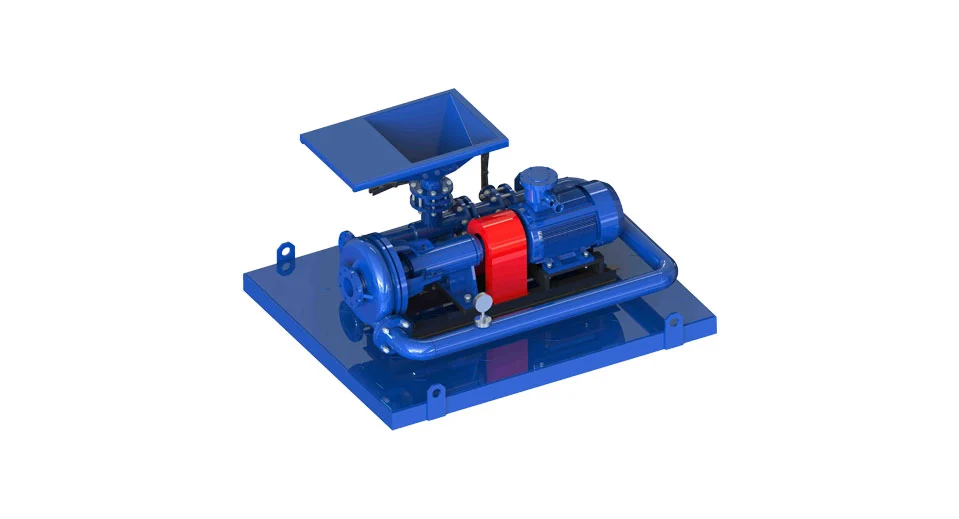When drilling into the earth for oil, gas, or geothermal energy, various challenges arise, primarily associated with the drilling fluid, commonly referred to as "mud." Achieving the appropriate consistency and composition of this drilling mud is crucial for efficient, safe drilling operations. One vital piece of equipment, the mud mixer, ensures the right mixture is maintained. This article will delve into the intricacies of how the mud mixer works, emphasizing a particular component fundamental to its operation: the mud mixing hopper.

Mud mixers are essential tools in the oil and gas drilling industry, and their functionality is critical for successful drilling operations. They ensure that drilling fluid—comprising water, clay, and a mixture of chemicals—is consistently blended to achieve the correct density and viscosity. These parameters are crucial because they influence many aspects of the drilling process, including the stabilization of well walls, the control of downhole pressures, and the easy removal of drill cuttings.
Without a reliable mud mixer, drilling teams would struggle to maintain the efficiency and safety of the drilling process. Mud mixers vary widely in design and complexity, ranging from small, portable units to massive, fixed installations. Some common brands in the market include NOV, M-I SWACO, and Halliburton, each offering various models tailored to different drilling scenarios.
Central to the operation of mud mixers is the mud mixing hopper. This specialized device allows for the efficient introduction of dry materials and additives into liquid drilling fluids. At its core, it operates on the principles of fluid dynamics, leveraging differential pressures and mechanical agitation to achieve uniform mixing.
Key Components:
Hopper Funnel: The top portion where dry materials are introduced. It's typically designed to minimize spillage and ensure a steady flow into the mixing chamber.
Mixing Chamber: The central part where the dry and liquid components meet. This is where the action happens.
Venturi throat: A narrowing section within the mixing chamber increases the velocity of the fluid, creating a low-pressure area that aids in sucking the dry materials into the liquid flow.
Agitators and Blenders: Mechanical devices within the mixing chamber break down clumps and ensure thorough mixing.
Process Flow:
When the drilling mud components are introduced through the hopper funnel, the liquid drilling fluid is simultaneously pumped through the system. As the fluid passes through the Venturi throat, its increased velocity creates a vacuum that draws the dry materials from the hopper into the liquid flow. The combined action of the high-velocity flow and mechanical agitators ensures thorough mixing, resulting in a consistent drilling fluid ready for use.
Proper installation of the mud mixing hopper is paramount to ensure its optimal performance. Although specific steps might vary depending on the brand and design, the general process remains consistent.
Preparation:
1. Site Assessment:** Evaluate the space where the hopper will be installed. Ensure adequate room for operation, maintenance, and safety protocols.
2. Foundation:** The hopper should be placed on a stable, level foundation to prevent vibrations and ensure consistent operation.
Installation Steps:
1. Positioning: Place the hopper in its designated spot, ensuring alignment with other components of the mud mixing system.
2. Connection: Securely connect the inlet and outlet pipes, ensuring they are free of obstructions and leaks. Double-check the orientation to ensure the correct flow direction.
3. Power and Controls: Connect the hopper to its power source and control systems. Ensure that all electrical connections are secure and meet safety standards.
4. Calibration: Before operational use, conduct calibration tests to ensure that the hopper's flow rates and mixing ratios meet the required specifications.
Operating a mud mixer requires a clear understanding of its components and functions to ensure optimal performance and safety. While specifics can vary by brand and model, the basic operational steps are similar.
Pre-Operation Checks:
1. Inspect the Equipment: Ensure that all components of the mud mixer, including the mud mixing hopper, are in good condition and free of damage or wear.
2. Verify Connections: Check that all connections, both electrical and mechanical, are secure and properly aligned.
3. Safety Measures: Ensure that all safety protocols are in place, including the use of personal protective equipment (PPE) and adherence to safety guidelines.
Operating the Mixer:
1. Start-Up: Initiate the mixer by turning on the power and allowing the system to reach its operational speed.
2. Add Materials: Gradually introduce the dry materials into the mud mixing hopper. Avoid overloading to prevent clogging and ensure even distribution.
3. Monitor the Mix: Continuously monitor the consistency and composition of the drilling fluid, making adjustments to the feed rate and mixing parameters as needed.
4. Adjust Settings: Based on the real-time monitoring, adjust the settings to maintain the desired viscosity and density of the drilling mud.
Post-Operation:
1. Shutdown Procedure: Properly shut down the mixer, following the manufacturer's guidelines to prevent damage or wear.
2. Maintenance: Conduct routine maintenance checks, including cleaning the hopper and mixing chamber, inspecting agitators, and verifying the integrity of connections.
In the complex world of drilling, achieving the perfect mix of drilling mud is crucial for a successful operation. The mud mixer, with its essential component—the mud mixing hopper—ensures that drilling teams have the right tools to maintain the optimal drilling fluid composition. By understanding the working principle, installation process, and operational steps, teams can maximize the efficiency and safety of their drilling activities. Brands like BZ solid control oil drilling company continue to innovate in this space, offering advanced solutions that cater to the evolving needs of the drilling industry. Knowing how to effectively use and maintain these mixers can significantly enhance drilling performance and ensure safety in operations.